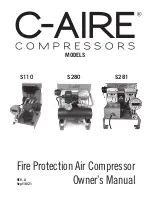
FORM QCC3-EG1 (517)
QUANTECH
15
Selection Data (Cont'd)
REFRIGERANT LINE SIZING
Refrigerant piping systems must be designed to provide practical line sizes without exces-
sive pressure drops, prevent compressor oil from being “trapped” in the refrigerant piping,
and ensure proper flow of liquid refrigerant to the thermal expansion valve. Consider-
ations should be give to:
1.
Suction line pressure drop due to refrigerant flow.
2. Suction line refrigerant velocity for oil return.
3.
Liquid line pressure drop due to refrigerant flow.
4. Liquid line pressure drop (or gain) due to vertical rise of the liquid line.
Table 4 - REFRIGERANT LINE CONNECTIONS on page 17
provides the pressure
drops for given pipe sizes for both liquid and suction lines. The pressure drops given are
per 100 equivalent ft. (30.5 m) of refrigerant piping. These friction losses do not include
any allowances for strainer, filter drier, solenoid valve, isolation valve or fittings.
Nominal pressure drop for solenoids, sight glass, and driers are shown in
Table 2 - MIS-
CELLANEOUS LIQUID LINE PRESSURE DROPS on page 16
.
Table 3 - REFRIGERATION PIPING CHARGES on page 16
includes approximate
equivalent lengths for copper fittings.
To ensure a solid column of liquid refrigerant to the expansion valve, the total liquid line
pressure drop should never exceed 50 psi (3.4 bar). Refrigerant vapor in the liquid line
will measurably reduce valve capacity and poor system performance can be expected.
To allow adequate oil return to the compressor, suction risers should be sized for a mini-
mum of 1000 FPM (5.08 m/s) while the system is operating at minimum capacity to ensure
oil return up the suction riser. Refer to
Table 5 under column labeled Nominal Tons (KW)
Unloaded.
Evaporator Below Condensing Unit
On a system where the evaporator is located below the condensing unit, the suction line
must be sized for both pressure drop and oil return. In some cases a double suction riser
must be installed to ensure reliable oil return at reduced loads. Table 3 indicates when a
double suction riser should be used for listed pipe sizes to provide adequate oil return at
reduced loads. The calculated information was based on maintaining a minimum of 1000
fpm (5.08 m/s) refrigerant vapor velocity.
Condenser Below Evaporator
When the condensing unit is located below the evaporator, the liquid line must be de-
signed for both friction loss and static head loss due the vertical rise. The value of static
head loss of 5 psi/ft.(3.4 kPa/30 cm) must be added to the friction loss pressure drop in
addition to all pressure drops due to driers, valves, etc.
Содержание QCC3
Страница 4: ...QUANTECH FORM QCC3 EG1 517 4 THIS PAGE INTENTIONALLY LEFT BLANK...
Страница 39: ...FORM QCC3 EG1 517 QUANTECH 39 THIS PAGE INTENTIONALLY LEFT BLANK...
Страница 40: ...QUANTECH FORM QCC3 EG1 517 40 Electrical Drawings LD22075a...
Страница 41: ...FORM QCC3 EG1 517 QUANTECH 41 Electrical Drawings Cont d 035 21583 101 REV O LD22075b...
Страница 42: ...QUANTECH FORM QCC3 EG1 517 42 Electrical Drawings Cont d LD22195a...
Страница 43: ...FORM QCC3 EG1 517 QUANTECH 43 Electrical Drawings Cont d LD22195b 035 21583 114 REV J...
Страница 59: ...FORM QCC3 EG1 517 QUANTECH 59 Notes...
















































